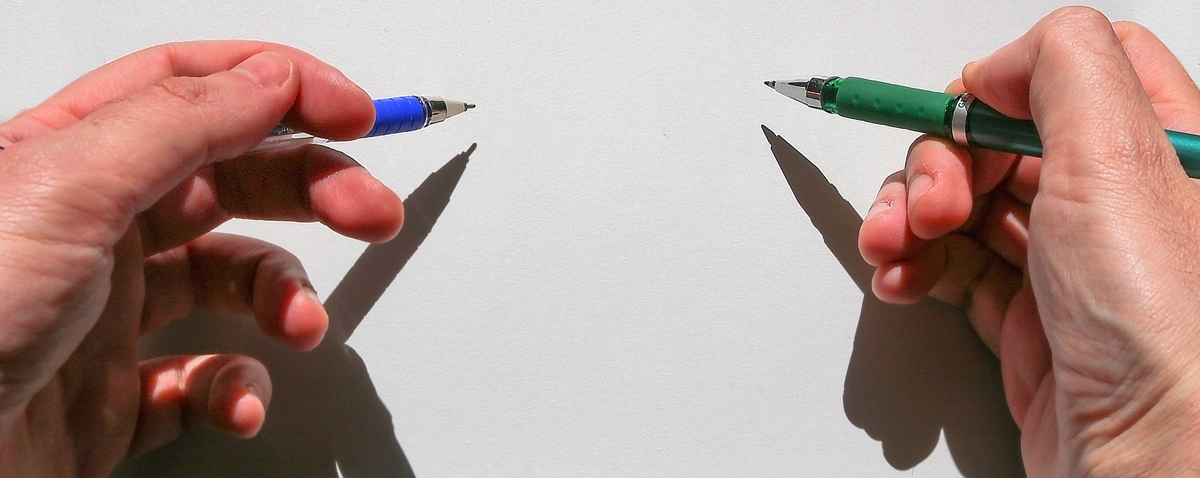Background
Handedness or hand preference is the tendency of people to be more capable and comfortable using one hand instead of the other when doing activities, such as writing and throwing a ball. It becomes increasingly apparent in early childhood and tends to be consistent throughout life. But little is known about its biological basis. Hand preference often arises as part of the developmental process that differentiates the right and left sides of the body. It also appears to be related to differences between the right and left halves of the brain. [1]
Based on research, in Western countries, 85 to 90 percent of the population are right-handed, while 10 to 15 percent are left-handed. But in addition to them, there is also mixed-handedness, or preferring different hands for different tasks, as well as ambidextrousness, or the ability to do tasks equally well with either hand, which are both uncommon. [1]
Can you tell what Albert Einstein, LeBron James, Benjamin Franklin, Dan Aykroyd, and Leonardo da Vinci have in common? In addition to being prominent people, all of them are ambidextrous. [2] A person is considered ambidextrous if he or she can use both his or her hands to perform tasks. With this, what do you think is the prevalence of ambidexterity, and what do you think are its benefits and challenges? If you have the same questions in mind, we are here to help you. In this post, we are giving you more information about the odds of being ambidextrous.
What is Ambidexterity and Its Causes?

If you can utilize both of your hands to perform tasks, it means that you are ambidextrous. There are times when ambidexterity is referred to as mixed-handedness. However, note that these terms are slightly different. It’s because mix-handedness is the tendency to use different hands for different tasks, which refers to preference and not skill. Ambidexterity, on the other hand, is the capability to use either hand to competently perform tasks.
The exact cause of being ambidextrous is unknown, but there are several theories, such as:
Cultural Preference for Right-Handedness
It is believed that many people who are ambidextrous are actually left-handed people who have taught themselves how to use their right hand due to the cultural preference for right-handedness. When you think about it, there are actually a lot of objects that are designed for right-handed people, such as can openers, scissors, and classroom chair desks.
This is why one theory is that ambidexterity comes about when left-handed people utilize right-handed objects. There are actually many people who identify as ambidextrous who write with their right hand, which may put emphasis on how society prefers right-handedness. [3]
Genetics
It may also be possible for genetics to play a role in the cause of ambidexterity. In 2021, a study found seven gene variants that are connected with ambidexterity. But more research is still needed in order to understand these variants. [3]
Pain or Injury
Another possible explanation for becoming ambidextrous is pain or injuries. For instance, if a left-handed person injures their dominant hand, they may be forced to do tasks with their other hand. With this, they can become two-handed or ambidextrous. The same can be right for a right-handed person who hurts their dominant hand and learns to use their left hand. [3]
Imbalanced Coordination Between Brain Hemispheres
The human brain has left and right hemispheres. These areas work together to perform different functions, such as remembering information. Some believe that ambidexterity may be due to an imbalance in this coordination. But still, more studies are needed to be made in order to understand this further. [3]
Prevalence of Ambidexterity

Let us go back to the main question for this article. What do you think are the odds of being ambidextrous? Well, determining the exact prevalence of ambidexterity in the general population is quite challenging because there is no universally accepted definition or criteria for identifying ambidextrous people. It is rare to find true ambidextrous people or those who are equally proficient with both hands. In fact, based on studies, only about 1% of the population is ambidextrous. [3] Therefore, it is also difficult to determine the odds of being ambidextrous.
It is also important to note that the prevalence of ambidexterity can vary depending on various factors, such as gender, age, and cultural background. For instance, a 2021 study suggests that being ambidextrous is more common in males than females. [3] Also, cultural attitudes towards left-handedness may also influence the prevalence of ambidexterity in different parts of the world.
The Advantages and Challenges of Being Ambidextrous
Like most things, being ambidextrous can have its share of benefits and challenges. In this part of the article, we are going to explore the advantages and challenges of being ambidextrous. This will allow us to further understand how ambidexterity can benefit people in different aspects, along with the challenges that they may face.
Advantages of Being Ambidextrous
Obviously, the main advantage of ambidexterity is the ability to write with both hands. But in addition to that, we’ve also researched the other advantages that ambidextrous people experience.
According to a few people who claim to be ambidextrous, there are some advantages to it, such as feeling comfortable grabbing anything with any hand. In addition to that, using both hands to do things helps them to finish tasks much more quickly. For instance, some are able to draw using both hands, which makes it faster to finish. Some also claim that they learned to type fast. [4]
Another advantage of being ambidextrous is that they are not crippled when they injure one hand, as they can still perform tasks with the other. Some also say that they are able to trim their nails easily and paint their nails well using both hands. And for most of them, ambidexterity is simply a cool thing that may both amaze and confuse other people. [4]
Challenges of Being Ambidextrous
According to some people who claim to be ambidextrous, one challenge they face is the lack of a weaker arm, which implies a lack of a stronger arm. For instance, when it comes to lifting heavy objects, both of their arms may feel discomfort, unlike most left or right-handers who only experience discomfort on one arm but not the other. [4]
There are also others who say that they sometimes become confused when it comes to their sense of direction or remembering where the left or right side is. Some also claim that they experience slight mental fragmentation or easily get lost in thoughts as well as difficulty in making a balance between creative thoughts and logical opinions. [4]
However, you need to note that the advantages and challenges of being ambidextrous still vary per individual. Two or three people experiencing these advantages and challenges does not mean all people who are ambidextrous also experience them.
Ambidexterity and Disorders

In addition to the advantages and challenges of being ambidextrous, another question is, are there any risks associated with being ambidextrous? Since the research on ambidexterity is lacking, no studies have explicitly examined the connection between being ambidextrous and health risks.

But some researchers have examined the risks that are associated with mixed-handedness, which also involves the use of different hands for certain tasks, similar to ambidexterity. Below are some of the disorders that may be associated with ambidexterity according to science:
Attention Deficit Hyperactivity Disorder (ADHD)
Based on a 2010 study, mixed-handedness is connected to atypical cerebral laterality. And it is also linked to ADHD in children and adolescents. Cerebral laterality pertains to the circumstance wherein one side of the brain focuses on certain functions while the other side focuses on others. This is also known as lateralization of brain function. In a 2015 study, researchers noted that non-right handedness is associated with ADHD symptoms, and that includes ambidextrous people and those who were originally left-handed. [3]
Schizophrenia
There is also some speculation that ambidextrous and mixed-handed people have higher chances of developing schizophrenia. Based on a study made in 2021, ambidexterity is connected with variants in the gene VRK2. According to a 2018 study, the gene is also involved in the development of schizophrenia and other major depressive disorders. In addition to that, in 2013, a study found a connection between left-handedness and schizophrenia. This association may also apply to ambidextrous individuals who are actually left-handed.
Post-Traumatic Stress Disorder (PTSD)
According to a study done in 2007, veterans who use both hands in battle are more likely to develop PTSD, which is a mental health condition that happens after experiencing a shocking event. Based on that study, atypical cerebral lateralization can be related to PTSD, which is thought to increase the sensitivity of a person to threats. As mentioned earlier, using both hands is connected to abnormal cerebral lateralization. This might explain the connection between ambidexterity and PTSD. However, more research and studies are still needed. [3]
Learning Difficulties
Unusual lateralization of the brain, which is involved in mixed handedness and ambidexterity, may also cause learning difficulties in children, based on a 2015 study. This may be related to challenges with skills such as writing pace, retrieving information, and verbal fluency. The same study also notes that children who have inconsistent hand tendencies are less coordinated compared to those who are just right- or left-handed, and this may affect learning in school. [3]
But then again, all of these are just theories, and more studies and research are needed in order to reach a conclusion that these disorders are really connected with being ambidextrous.
Fascinating Facts About Ambidexterity

Being ambidextrous is indeed a unique characteristic of some individuals. If you are eager to learn more about ambidexterity, below are more fascinating facts about it that you should learn about:
- Ambidextrous individuals are rarer than left-handed people. [5] Based on the American Psychological Association, 90% of the world population is right-handed, and the other 10% is left-handed or has some degree of ambidextrousness. But only 1% of the population is “true” ambidextrous. [7] This means that out of a hundred people, only one is ambidextrous. [5]
- If you are ambidextrous, you’ll be able to write legibly using both hands. [5]
- Ambidextrous people have symmetric brain hemispheres. This means that they have mixed senses. With this, studies also suggest that they are more prone to clumsiness, awkwardness, and moodiness. [5]
- Based on studies, a lot of factors can affect an ambidextrous view of things. These may include music, vibe, and surroundings. [5]
- The term “ambidextrous” means “both right.” [5]
- LeBron James is ambidextrous. With this, he is able to sign autographs and shoot hoops using both of his hands. [5]
- Ambidextrous people may not be good at academics. In one Finnish study, seven and eight-year-old kids completed various academic tests. Out of the 8,000 participants, 87 of them were comfortable using both hands. Based on the results, the ambidextrous students were 90% more likely to struggle with math problems and have difficulties with language compared to right-handed ones. [6]
- Ambidexterity often comes hand-in-hand with synesthesia. People who have synesthesia are able to hear colors or feel physical sensations that other people are feeling or even connect numbers with personalities. It is a brain condition that triggers more than one of the senses at once. A person with synesthesia is more likely to be left-handed or ambidextrous compared to the average person, as their brains also tend to be pretty symmetrical. [6]
- There are people who are called “ambisinistral.” They are those who have tried to train their brain to write or perform tasks using both of their hands or their non-dominant hand but are not as proficient. It is described as both hands being as skilled as a right-hander’s left hand. [7]
- There is a controversy among experts about whether or not you can train your brain to be ambidextrous. But some companies tout the idea that people can boost their brain power when they train to be ambidextrous. But according to other experts, it could have the opposite effect, and there are also no studies connecting handedness to intelligence. [7]
- According to a study published in the Neuropsychology journal, ambidexterity could give athletes an advantage in sports. It’s because the brain hemispheres of ambidextrous people react faster as they are more symmetrical, which allows them to do tasks faster. [7]
Conclusion
Being ambidextrous is indeed a rare trait that only a small percentage of the population possesses. Having this trait can provide individuals with unique advantages, including improved fine motor skills and flexibility. However, there may also be some challenges associated with it, such as potential confusion.
In conclusion, the odds of being ambidextrous are relatively low. But those who are ambidextrous have a unique set of skills and abilities that they can use in different aspects of their lives. We hope this post helped you further understand what ambidexterity is, its prevalence, advantages, and challenges.
References
[1] Medline Plus Editors. (2022, July 8). Is handedness determined by genetics? MedlinePlus. Retrieved April 3, 2023, from https://medlineplus.gov/genetics/understanding/traits/handedness/
[2] Celebrity Lists Editors. (2023, March 29). 26 celebrities who are ambidextrous. Ranker. Retrieved April 3, 2023, from https://www.ranker.com/list/ambidextrous-celebrities/celebrity-lists
[3] Nunez, K. (2022, April 28). Ambidextrous: Meaning, causes, and possible health effects. Healthline. Retrieved April 3, 2023, from https://www.healthline.com/health/ambidextrous#is-there-a-known-cause
[4] Hajj, J.-P., & Andres, B., et al. (2018). What are the advantages and disadvantages of being ambidextrous? Quora. Retrieved April 3, 2023, from https://www.quora.com/What-are-the-advantages-and-disadvantages-of-being-ambidextrous
[5] Alleah. (2022, June 17). 30 unexpected ambidextrous facts that will amaze you. Facts.net. Retrieved April 3, 2023, from https://facts.net/ambidextrous-facts/
[6] Jones, M. (2022, March 7). 10 fascinating facts you never knew about ambidextrous people. Reader’s Digest. Retrieved April 3, 2023, from https://www.rd.com/list/facts-ambidextrous-people/
[7] Jason. (2022, October 20). 25 bizarre facts about being ambidextrous. List25. Retrieved April 3, 2023, from https://list25.com/25-bizarre-facts-about-being-ambidextrous/

